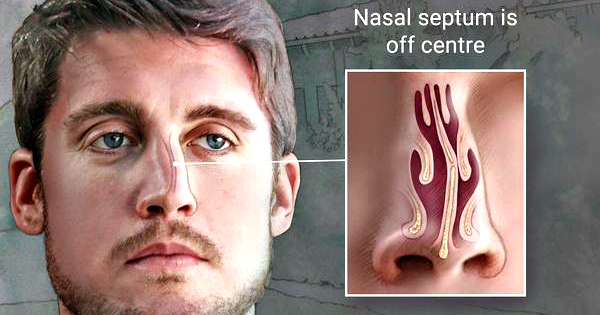Deviated Nasal Septum

A severe deviated septum can cause complications such as blocking one side of your nose and reducing the airflow, leading to difficulty in breathing. DVT also causes nasal obstruction, which mainly occurs due to swelling of the tissues lining the nose, or from both. Treatment includes medications but mainly surgery is recommended to treat DVT completely.
What are the symptoms of DVT?
DVT is usually a symptomless condition; however, DVT can cause the following signs and symptoms:
- Nostril obstruction. Obstruction due to DVT can hamper breathing. During conditions such as cold and upper respiratory infection this condition usually flares
- Bleeding from the nose DVT can make the lining of nasal septum dry, which increases the chances of nosebleeds.
- Noisy breathing during sleep. This can occur in infants and young children with a deviated septum or due to swelling of the intranasal tissues.
- Inclination for sleeping on a particular side. It has been observed that some of the affected individuals sleep on a particular side in order to optimize breathing through the nose at night. This primarily happens due to the deviated septum that makes one nasal passage narrow in size.
When it is important to visit a doctor?
- Blocked nostrils that do not respond to the treatment
- Bleeding from the nose
- Frequent Sinus infections
What are the causes of DVT?
Below are the causes of DVT:
- DVT could be a congenital problem, which means this condition is present from the childhood
- Nasal Injury. A deviated septum can also be the result of an injury that causes the nasal septum to be moved out of position. Injury happening during childbirth can cause DVT in infants. Trauma, accidents are a major cause of DVT in children and adults.
Risk factors
Deviated septum is present at birth is present from the time of birth in some of the individuals which happen during fetal development or due to injury during childbirth. In adults and children trauma is the major cause of DVT.
Some of the common risk factors include:
- Playing contact sports
- Non usage of driving belts while driving
What are the complications of DVT?
- Dry mouth, due to regular mouth breathing
- Pressure or congestion in nose
- An uncomfortable or disturbed sleep
Prevention of DVT
Trauma should be avoided to reduce the risk of DVT
- Wear a helmet or a mid face mask while playing sports such as football and volleyball.
- Wear a seat belt while driving.
How DVT is diagnosed?
During your visit, your doctor will first ask about any symptoms you may have.
An ENT specialist examines the nose with the help of specialized instruments to confirm the diagnosis of DVT
How DVT is treated?
Symptom management:
The first treatment is to reduce the symptoms caused by DVT. Following medications are usually prescribed to treat the symptoms of DVT:
- Decongestants. Decongestants are medications that minimize the nasal tissue swelling, which helps in keeping the airways on both sides of your nose open. Pill or as a nasal spray are used as decongestants.
- Antihistamines. Antihistamines are used to treat and prevent allergy symptoms, including obstruction and runny nose.
- Nasal steroid sprays. They are used to reduce the inflammation caused in the nasal passage due to DVT.
It is important to note that above mentioned medicines only curb the symptoms , but cannot treat the DVT.
If you still experience symptoms despite medical therapy, you may consider surgery to correct your deviated septum (septoplasty).
Septoplasty is the usual way to repair a deviated septum. During septoplasty, your nasal septum is straightened and repositioned in the center of your nose. At times, septoplasty is done in collaboration with rhinoplasty (surgery to improve the shape of the nose) to effectively treat DVT.


